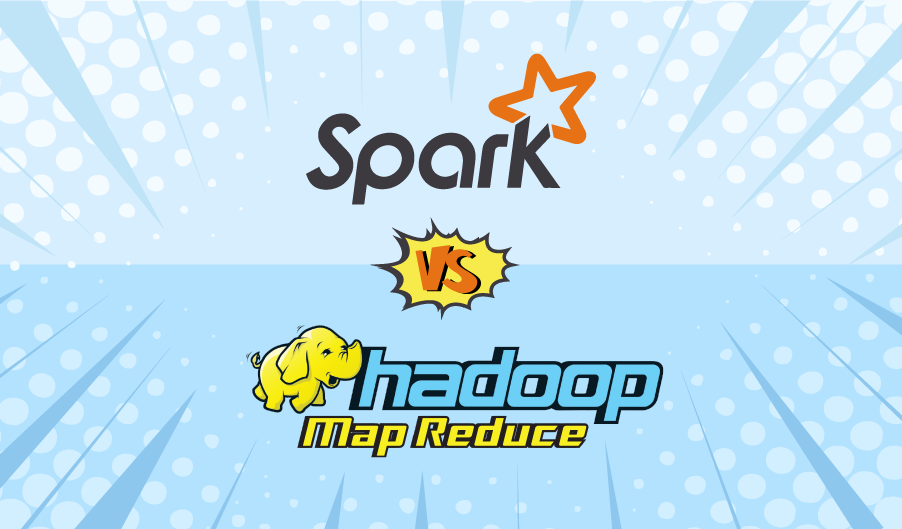Spark vs. Hadoop MapReduce: Which Big Data Framework to Choose
With multiple big data frameworks available on the market, choosing the right one is a challenge. A classic approach of comparing the pros and cons of each platform is unlikely to help, as businesses should consider each framework from the perspective of their particular needs. Facing multiple Hadoop MapReduce vs. Apache Spark requests, our big data consulting practitioners compare two leading frameworks to answer a burning question: which option to choose – Hadoop MapReduce or Spark.

A Quick Alance At The Market Situation
According to Datanyze reports, Hadoop and Spark are among the top five big data processing technologies. Hadoop (including MapReduce as part of the framework) is ranked #2 with more than 11,634 companies using the technology. Apache Spark is ranked # 5 and is used by 7,064 companies. The market shares of the techs are 11.72% and 7.12%, respectively. However, taking into account that calculations for Hadoop are made based on the adoption rates of different technologies of the Hadoop family, such as HDFS, YARN, and MapReduce, it’s possible to conclude that Hadoop MapReduce and Spark enjoy equal popularity.
To make the comparison fair, we will contrast Spark with Hadoop MapReduce, as both are responsible for data processing.
The Key Difference Between Hadoop MapReduce and Spark
In fact, the key difference between Hadoop MapReduce and Spark lies in the approach to processing: Spark can do it in-memory, while Hadoop MapReduce has to read from and write to a disk. As a result, the speed of processing differs significantly – Spark may be up to 100 times faster. However, the volume of data processed also differs: Hadoop MapReduce is able to work with far larger data sets than Spark.
Now, let’s take a closer look at the tasks each framework is good for.
Tasks Hadoop MapReduce Is Good For
- Linear processing of huge data sets. Hadoop MapReduce allows for parallel processing of huge amounts of data. It breaks a large chunk into smaller ones to be processed separately on different data nodes and automatically gathers the results across the multiple nodes to return a single result. In case the resulting dataset is larger than available RAM, Hadoop MapReduce may outperform Spark.
- A cost-efficient solution, if no immediate results are expected. Our Hadoop team considers MapReduce a good solution if the speed of processing is not critical. For instance, if data processing can be done during night hours, it makes sense to consider using Hadoop MapReduce.
|
Looking for practical examples rather than theory? Check how we implemented a big data solution to run advertising channel analysis. |
Tasks Spark Is Good For
- Fast data processing. In-memory processing makes Spark faster than Hadoop MapReduce – up to 100 times for data in RAM and up to 10 times for data in storage.
- Iterative processing. If the task is to process data again and again – Spark defeats Hadoop MapReduce. Spark’s Resilient Distributed Datasets (RDDs) enable multiple map operations in memory, while Hadoop MapReduce has to write interim results to a disk.
- Near real-time processing. If a business needs immediate insights, then they should opt for Spark and its in-memory processing.
- Graph processing. Spark’s computational model is good for iterative computations that are typical in graph processing. And Apache Spark has GraphX – an API for graph computation.
- Machine learning. Spark has MLlib – a built-in machine learning library, while Hadoop needs a third-party to provide it. MLlib has out-of-the-box algorithms that also run in memory. But if required, our Spark specialists will tune and adjust them to tailor to your needs.
- Joining datasets. Due to its speed, Spark can create all combinations faster, though Hadoop may be better if joining of very large data sets that requires a lot of shuffling and sorting is needed.
|
Interested how Spark is used in practice? Check how we implemented a big data solution for IoT pet trackers. |
Spark vs. Hadoop MapReduce: The Ultimate Comparison
| Parameter | Spark | MapReduce |
| Memory usage and efficiency in handling large datasets | Requires sufficient RAM. Best for operations that fit into the available memory. | Relies heavily on disk storage and is suitable for datasets that are larger than the available RAM capacity. Best for very large data sets with data volume exceeding the available memory. |
| Convenience for developers | Simplifies development (due to APIs in Python, Scala, Java, R), and the support for interactive shells and built-in libraries for SQL, machine learning, graph processing, streaming. | Requires developers to write more boilerplate code and doesn’t have an interactive mode. Can be used with Apache Impala and or Hive to simplify the process. |
| Security | Lacks independent security features and relies heavily on integration with the elements of the Hadoop ecosystems, e.g., HDFS, YARN. | Mature security features are inherent to the Hadoop ecosystem, e.g., authentication, authorization, and encryption mechanisms. |
| Compatibility | Compatible with a variety of data sources, storage, and formats, cluster managers, and programming languages, including outside the Apache ecosystem (e.g., Amazon S3 and Azure Data Lake Storage). | Closely tied to the Apache ecosystem. Mostly compatible with HDFS for data storage and YARN for cluster management, covers only Hadoop-supported data formats such as sequence files. |
| Best use cases from a technical perspective | Fast in-memory tasks, such as iterative processing, real-time, and graph processing, machine learning and artificial intelligence workloads. | Linear processing of huge datasets. |
| Best use cases from a business perspective |
|
|
Which Framework to Choose?
Many sources state that Spark is gaining more popularity than MapReduce. However, the tendency is driven by the increasing need for real-time and ML/AI-associated workloads and not by the fact that MapReduce is worse by design. So, the bottom line is that the exact technology choice will depend on the particular use case.
Linear processing of huge datasets is the advantage of Hadoop MapReduce, while Spark delivers iterative processing and real-time analytics on smaller-scale datasets. However, in many cases, we have found that Spark can be added alongside Hadoop MapReduce instead of completely replacing it. The great news is that the Spark is fully compatible with the Hadoop ecosystem and works smoothly with Hadoop Distributed File System, Apache Hive, etc.

